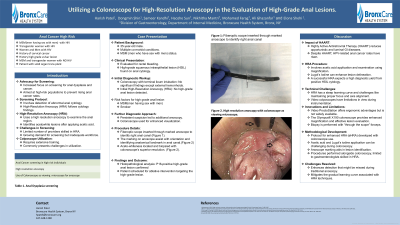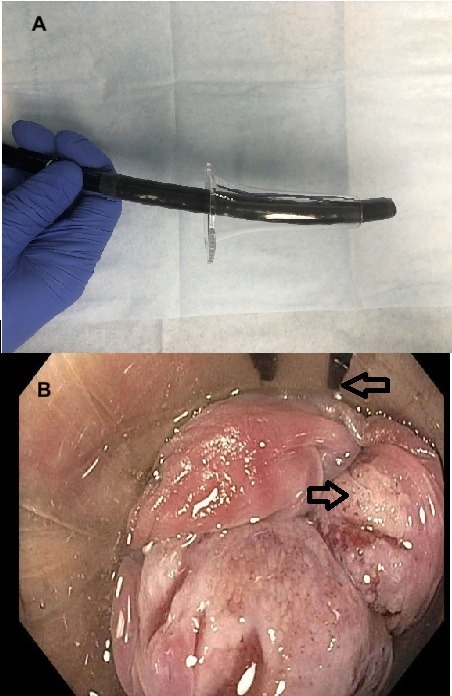Monday Poster Session
Category: General Endoscopy
P2437 - Utilizing a Colonoscope for High-Resolution Anoscopy in the Evaluation of High Grade Anal Lesions
Monday, October 28, 2024
10:30 AM - 4:00 PM ET
Location: Exhibit Hall E

Has Audio
- HP
Harish Patel, MD
BronxCare Health System
Bronx, NY
Presenting Author(s)
Harish Patel, MD1, Dongmin Shin, MD1, Sameer Kandhi, MD1, Haozhe Sun, MD1, Nikhitha Mantri, MD1, Mohamed Farag, MD1, Ali Ghazanfar, MBBS2, Elona Shehi, MD1
1BronxCare Health System, Bronx, NY; 2Fauji Foundation Hospital, Rawalpindi, Punjab, Pakistan
Introduction: Advocacy for anal dysplasia cancer screening among high-risk populations has increased as a preventive measure against the increasing incidence of anal cancer. Screening includes initial evaluation with anal cytology and identifying individuals with high-grade squamous intraepithelial lesion (HSIL), who then undergo high resolution anoscopy (HRA) to identify the high grade anal lesion. Ablation of these lesions has been a preventative step for anal cancer. Utilizing colposcopes for HRA has a steep learning curve. We present a case where the utilization of a colonscope enhanced diagnostic yield in identifying high-grade anal lesions.
Case Description/Methods: A 35-year-old male patient with multiple co-morbid conditions and MSM (men who have sex with men) status, underwent evaluation for rectal bleeding and a high-grade squamous intraepithelial lesion (HSIL) on anal cytology. His colonoscopy with terminal ileum intubation did not reveal any significant findings aside from external hemorrhoids. Initial high-resolution anoscopy (HRA) was unrevealing for any high grade anal lesion. Given the persistent suspicion of high-grade anal lesion, subsequent anoscopy was conducted using a colonoscope for enhanced visualization. The fiberoptic scope can be inserted through an anoscope that is marked to identify the anatomical sites of the anal canal (Figure A). With the superior resolution of a colonoscope, the acetowhiteness was identified and biopsied (Figure B). Histopathological analysis confirmed a P16-positive high-grade anal lesion. Subsequently, the patient is scheduled for an ablative intervention targeting the high-grade anal lesion.
Discussion: The use of a colonoscope as a viewing microscope can be a strategic solution in overcoming the technical complexities associated with high-resolution anoscopy (HRA). Gastroenterologists can effectively address the escalating demand of anal dysplasia screening with their current endoscopy setup.

Disclosures:
Harish Patel, MD1, Dongmin Shin, MD1, Sameer Kandhi, MD1, Haozhe Sun, MD1, Nikhitha Mantri, MD1, Mohamed Farag, MD1, Ali Ghazanfar, MBBS2, Elona Shehi, MD1. P2437 - Utilizing a Colonoscope for High-Resolution Anoscopy in the Evaluation of High Grade Anal Lesions, ACG 2024 Annual Scientific Meeting Abstracts. Philadelphia, PA: American College of Gastroenterology.
1BronxCare Health System, Bronx, NY; 2Fauji Foundation Hospital, Rawalpindi, Punjab, Pakistan
Introduction: Advocacy for anal dysplasia cancer screening among high-risk populations has increased as a preventive measure against the increasing incidence of anal cancer. Screening includes initial evaluation with anal cytology and identifying individuals with high-grade squamous intraepithelial lesion (HSIL), who then undergo high resolution anoscopy (HRA) to identify the high grade anal lesion. Ablation of these lesions has been a preventative step for anal cancer. Utilizing colposcopes for HRA has a steep learning curve. We present a case where the utilization of a colonscope enhanced diagnostic yield in identifying high-grade anal lesions.
Case Description/Methods: A 35-year-old male patient with multiple co-morbid conditions and MSM (men who have sex with men) status, underwent evaluation for rectal bleeding and a high-grade squamous intraepithelial lesion (HSIL) on anal cytology. His colonoscopy with terminal ileum intubation did not reveal any significant findings aside from external hemorrhoids. Initial high-resolution anoscopy (HRA) was unrevealing for any high grade anal lesion. Given the persistent suspicion of high-grade anal lesion, subsequent anoscopy was conducted using a colonoscope for enhanced visualization. The fiberoptic scope can be inserted through an anoscope that is marked to identify the anatomical sites of the anal canal (Figure A). With the superior resolution of a colonoscope, the acetowhiteness was identified and biopsied (Figure B). Histopathological analysis confirmed a P16-positive high-grade anal lesion. Subsequently, the patient is scheduled for an ablative intervention targeting the high-grade anal lesion.
Discussion: The use of a colonoscope as a viewing microscope can be a strategic solution in overcoming the technical complexities associated with high-resolution anoscopy (HRA). Gastroenterologists can effectively address the escalating demand of anal dysplasia screening with their current endoscopy setup.

Figure: Figure. Demonstration of a colonoscope used as a viewing microscope for anoscopy (A) Acetowhite lesion identified on high resolution anoscopy with a colonoscope (B)
Disclosures:
Harish Patel indicated no relevant financial relationships.
Dongmin Shin indicated no relevant financial relationships.
Sameer Kandhi indicated no relevant financial relationships.
Haozhe Sun indicated no relevant financial relationships.
Nikhitha Mantri indicated no relevant financial relationships.
Mohamed Farag indicated no relevant financial relationships.
Ali Ghazanfar indicated no relevant financial relationships.
Elona Shehi indicated no relevant financial relationships.
Harish Patel, MD1, Dongmin Shin, MD1, Sameer Kandhi, MD1, Haozhe Sun, MD1, Nikhitha Mantri, MD1, Mohamed Farag, MD1, Ali Ghazanfar, MBBS2, Elona Shehi, MD1. P2437 - Utilizing a Colonoscope for High-Resolution Anoscopy in the Evaluation of High Grade Anal Lesions, ACG 2024 Annual Scientific Meeting Abstracts. Philadelphia, PA: American College of Gastroenterology.
